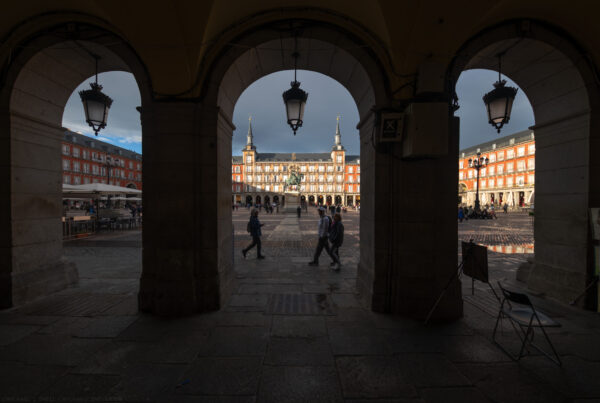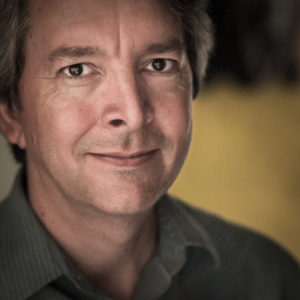Big plans for something small.
This could easily become a stupidly long post, but I’ll try and keep it brief.
Some time last year (2024) I began to think about how I shoot travel and what I would like to do differently since it looked like I might be hitting road a lot more again in 2025. Up until 2020, I was traveling quite a bit, mostly on organized, highly-scheduled press trips. In other words, I was often at the mercy of an itinerary and not meandering about on my own. I was usually with a group and the group keeps moving.
I feel like I’ve developed a good way of working in these fast-paced situations. I can plan ahead as much as possible and adapt quickly when surprises arise. Packing has always been a challenge, though. It’s difficult to make sure you have everything you’ll need with you, without carrying a whole lot of unnecessary gear that you don’t end up using at all. This is made more difficult when the group is changing hotels frequently and you need to have some gear accessible, while the rest may be stowed away in the bottom of a bus or in the back of a van for the day.
So… challenges. They’re real.
During my lull in travel from 2020 to 2024, I had a lot of time to think about how I work and what I’d like to do better. One thing I’ve always struggled with is how to capture more of the travel “experience” as opposed to just capturing the “destination.” Because of how I have to pack for travel days (in airports, on trains, etc.) I don’t always have quick, easy access to my gear. If I want to grab a quick shot in the airport or on a train platform, I need to have a camera available — easily available, and ready to go. Something pocketable would be ideal.
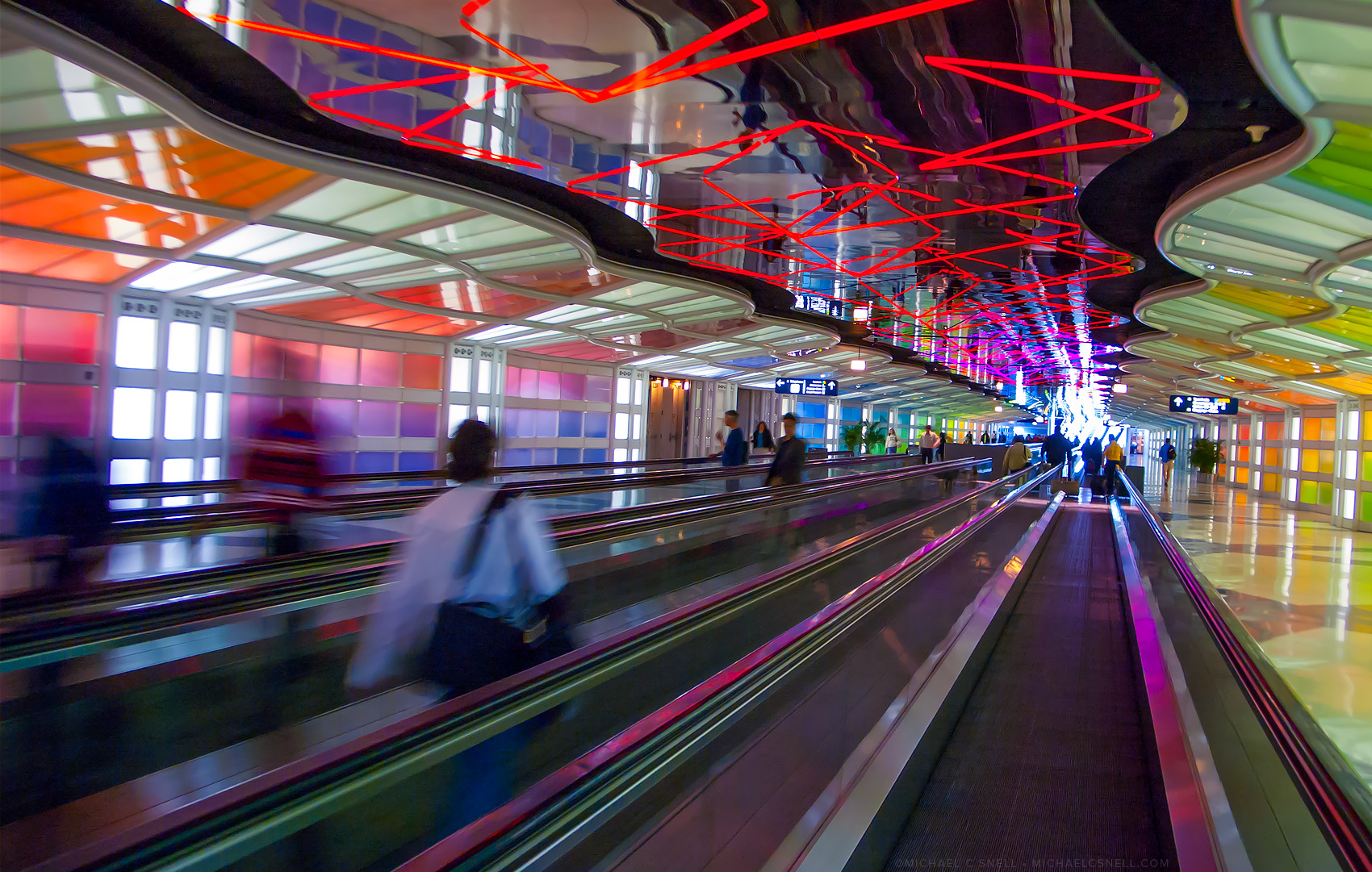
This is an example of the kind of image I typically only take if I have a point-and-shoot in my pocket. This underground walkway in O’Hare International Airport is one of those places I’m only ever in when I’m in transit, moving fast, and have all my pro gear packed up. It’s nice to have a small camera on hand and available to grab this kind of photo that tells the story of the journey itself. Not just the destination.
I’ve had some compact cameras like this in the past. One of my favorites probably being a Panasonic Lumix DMC-LX1. It only had an 8mp sensor, but it was 16×9 format and it could shoot video. This was around 2005 and this camera was tiny. I remember taking it to South Korea and using it a lot during performances, in restaurants, and generally any place where I either didn’t have my “big camera” handy or where it would have been too obtrusive. I still have that camera, but I just stopped using it at some point. I’m not sure why, but I’m guessing it gradually was replaced by my phone’s camera.
The big plan.
So in mid-2024, I decided to get a new compact, all-in-one camera to become my new EDC (Every Day Carry).
I have no complaints with my Nikon D850 and the lenses I have collected for it. The Nikon will remain my primary camera system. The easy thing to do, I suppose, would have been to add a Nikon mirrorless that was small but fit into the same ecosystem, used the same lenses. In looking at the Nikons, however, they didn’t seem that much smaller than my DSLR, and by the time you put a lens adapter on to make use of my old f-mount lenses, there wasn’t much to gain. Nothing pocketable, as far as I was concerned, and I do still like an optical viewfinder which to my knowledge isn’t available in a Nikon mirrorless.
Fujifilm’s camera offerings called to me. My first SLR was a Fujica ST-701 and I used Fuji’s films for most of my pre-digital career. So there’s some nostalgia there for me.
Fujifilm’s approach to digital is a little different. They use a different kind of sensor for one, and they offer film simulations using color science that goes back to their film days. You can choose to shoot digital with a vivid Velvia-like flavor, or a more portrait-friendly Provia simulation. It appeals to me because, instead of just adding a compact version of what I already have, I can be adding some more tools and flavors to my kit. I can expand my range of looks and styles when shooting.
In March of 2024 the Fujifilm X100vi was released — the sixth incarnation of the famed X100 line of fixed lens, rangefinder style cameras. They, along with their X-Pro big brothers, also offered unique optical and digital hybrid viewfinders. Back in the film days, I’d coveted a friend’s Contax G2 rangefinder, and the Fuji X100 line seems very similar — albeit in a digital form.

A product photo I found online of the X100vi prior to ordering my own. Available in silver or black, I went with black. It feels a bit more discreet and I’ve always liked having black camera bodies because they don’t show up in window reflections, etc. as much as bright silver bodies.
The backorder.
The X100vi has been ridiculously popular right out of the gate and even though I ordered on October 1, they were still in a backorder situation since the preorders back in March. I had my next trip coming up in January of 2025, and crossed my fingers that I’d have it in time. I did not. It would have been a perfect trip for learning a new camera system because that trip (to Valencia, Spain) was all on my own and unscheduled. But it was not meant to be.
So, for Valencia, I tried to make do with my phone as that compact, always-with-you camera. It was okay, but for me the experience of shooting with a phone is just not the same. And I feel like to get the most out of it, shooting raw for instance, it requires a lot of little workarounds and hassles. Probably if I devoted myself to it I could make it workable, but it’s just not what I’m looking for.
Back from Valencia, I had until May before my next trip. Every couple of weeks I was getting an email saying the camera was still backordered and, as May approached, I worried that another trip was going to come and go without having the Fuji in my hands. Worse yet, the next trip I have lined up is in June/July and it will be the exact kind of highly-scheduled trip that I want the Fuji for. I really wanted to get the camera in my hands for the May trip so that I had a practice run before the really challenging travel arrived.
The backup plan.
So on April 5, I decided to order a used camera to act as a back-up to the X100vi should it fail to arrive in time for my May trip. Oddly, I could have ordered a used X100vi for a couple of hundred dollars more than they sold for new, but I didn’t really want to reward those who bought cameras on speculation only to try and profit from them afterward at the expense of all those still waiting on backorders.
Instead, I decided to get a used X-Pro 3. It’s very similar in style to the X-100vi but is slightly bigger and it accepts interchangeable lenses. It’s also a generation older so, even though it’s the “pro” model it has a smaller sensor — 27mp compared to the X100vi’s 40mp. My thinking with the X-Pro was that it was similar enough in build and functionality that I could start learning the Fuji system and not be starting fresh when the X100 finally arrived. When the backorder was finally fulfilled, I could decided whether to keep both or sell the X-Pro 3 off again.
Realizing that I might soon have two very similar cameras on my hands, I decided to pair the X-Pro 3 with lenses that were different from the built-in 23mm of the X100vi. I ordered a Voigtlander 18mm pancake lens (to have something nearly as compact as the 23mm) and a Fujinon 35mm f2 that’s considered a classic for this system by many.
This way, if I ended up with both cameras, I would have a range of focal lengths — 18mm (similar to a 28mm full frame), 23mm (35mm equivalent) and a 35mm (50mm equivalent). No duplication and I can continue to expand with more lenses for the X-Pro 3 later should I want to.
When it rains it pours.
I got notification that my used X-Pro had shipped on April 9. The following day, April 10, I finally received notification that my backordered X100vi had arrived and was being shipped to me. In the end, I received the two cameras just days apart. The X-Pro 3 order was probably unnecessary, but what are you going to do? I couldn’t have known when the backorder would show up. After all, it had been over six months since I’d placed the order.
So on April 15th I had both cameras in hands. On April 16th, FujiRumors.com announced that Fujifilm planned “to suspend orders for Fujifilm GFX100RF, along with suspension for X-M5 black and X100VI orders” citing uncertainty over the newly imposed tariffs.
I got in just under the wire, it would appear. I’m actually very happy with both cameras so far and I think I’ll be keeping both, even though the X-Pro 3 isn’t strictly necessary at this point. But it will be nice to have for additional focal length options, and any lenses I acquire for it will be usable on a future X-Pro 4 or 5, whenever that update finally arrives.
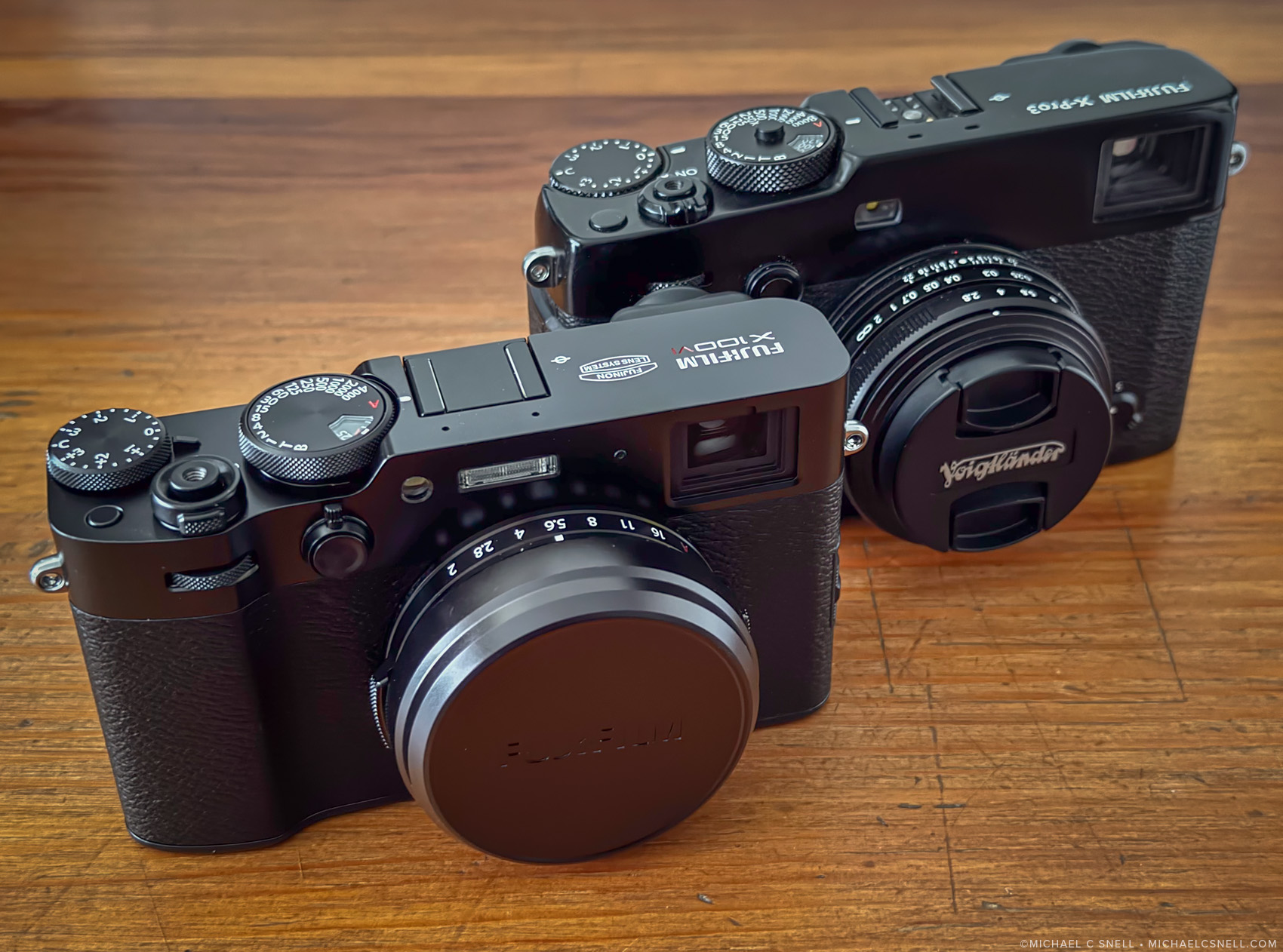
The new X100vi (front) with the used X-Pro 3 behind with the Voigtlander 18mm mounted.
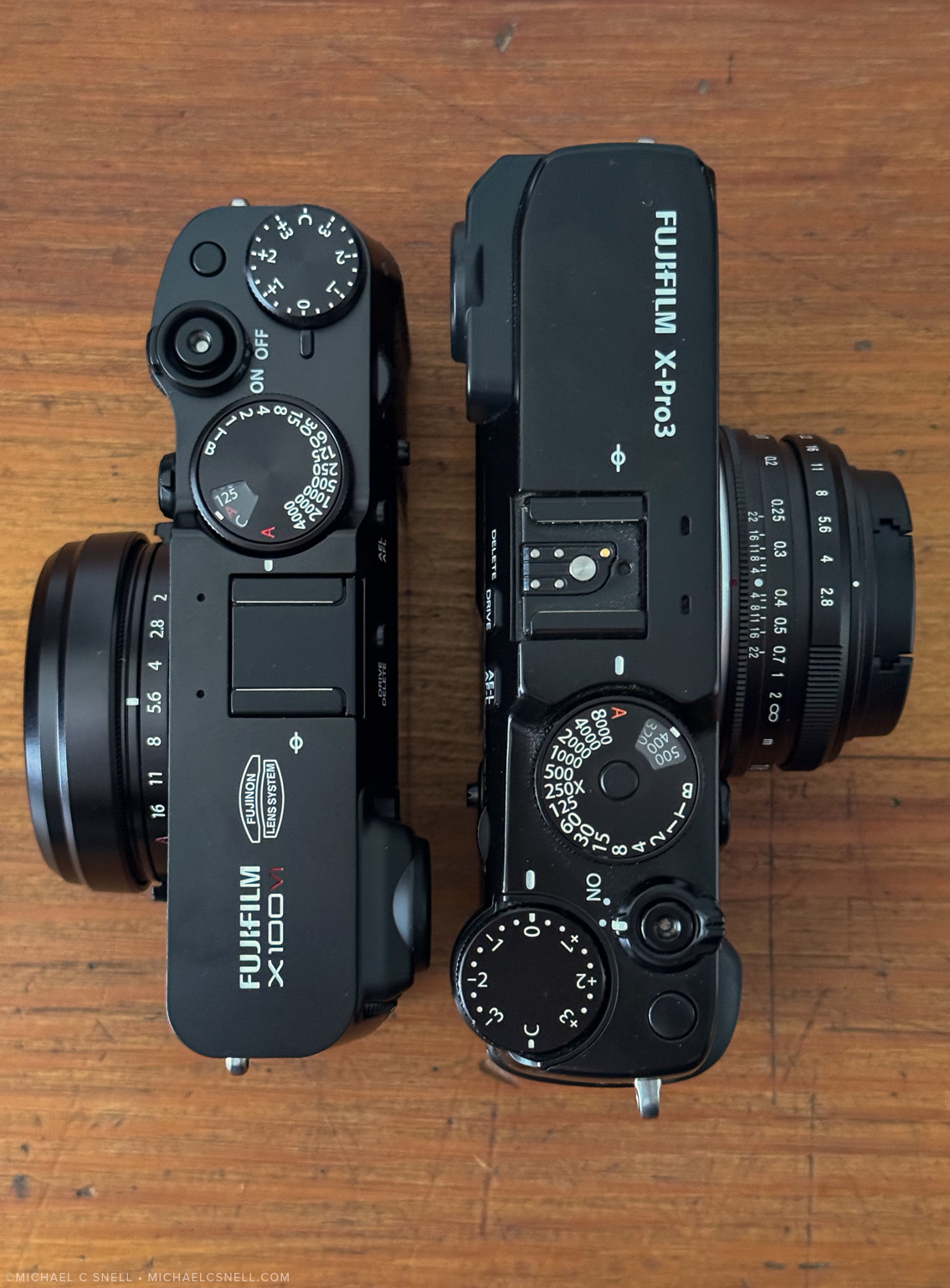
In this top-down shot, you get a good idea of the size difference between these two cameras. It’s not a huge difference with the 18mm pancake lens mounted on the X-Pro 3 but the X100vi (left) is a bit easier to get into a jacket pocket.
What’s next?
Now the long learning curve begins. It really is a very different system to what has become second nature to me with the Nikon, so I’m digging in and working hard to figure it all out. From what I can tell, the initial setup is what’s going to be most arduous for me. Once I’m past that, I can have all of my custom function buttons set where I want to be able to access needed controls without having to dig through menus any more.
I’ll post more as this process evolves, but this post is long enough already. Thanks for sticking with me. I think the upcoming learning and experimentation will be much more entertaining.


